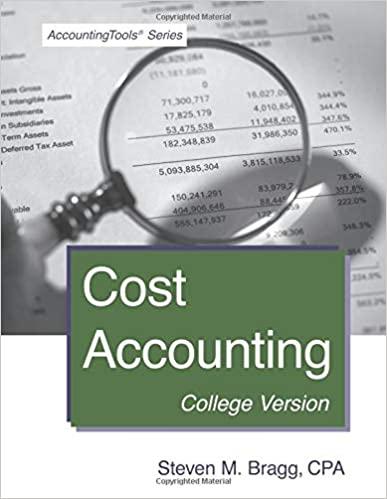Question
11. The effect of transactions on ratios Youve been asked to teach Skyla, a finance student who doesnt feel comfortable about her understanding of the
11. The effect of transactions on ratios
Youve been asked to teach Skyla, a finance student who doesnt feel comfortable about her understanding of the relationship between a companys business activities, its financial accounts, and the companys financial ratios. To better appreciate these relationships, youve created the following exercises for Skyla to complete. The purpose of these exercises is to help Skyla (1) understand the effect of business transactions on financial statementsuch as balance sheet and income statementaccounts and (2) how these changes in the numerators and denominators of financial ratios affect the ratios values. However, before using these exercises in your session later today, youll want to run the calculations on the following two business transactions, to verify the accuracy of your answers.
To provide a consistent frame of reference for the companys financial statements and ratios, assume that the following balance sheet and income statement reflect the companys pretransaction condition and performance.
Wellington Industriess Pretransaction Statement of Financial Condition
| Cash | $15,000 | Accounts payable | $20,000 |
| Marketable securities | 10,000 | Wages payable | 20,000 |
| Accounts receivable | 470,000 | Taxes payable | 10,000 |
| Inventory | 500,000 | Notes payable | 50,000 |
| Prepaid expenses | 5,000 | Total current liabilities | 100,000 |
| Total current assets | 1,000,000 | Long-term debt | 500,000 |
| Total liabilities | 600,000 | ||
| Gross plant and equipment | 1,500,000 | Common stock | 150,000 |
| Accumulated depreciation | 500,000 | Capital paid in excess of par | 350,000 |
| Net plant and equipment | 1,000,000 | Retained earnings | 900,000 |
| Total equity | 1,400,000 | ||
| Total assets | $2,000,000 | Total debt and equity | $2,000,000 |
| Wellington Industriess Pretransaction Statement of Financial Performance | |
|---|---|
| Sales | $5,000,000 |
| Less: Cost of goods sold | 2,000,000 |
| Gross profit | 3,000,000 |
| Less: Operating expenses | 600,000 |
| Operating profit (EBIT) | 2,400,000 |
| Less: Interest expense | 33,000 |
| Earnings before taxes (EBT) | 2,367,000 |
| Less: Tax expense | 828,450 |
| Net income | $1,538,550 |
Cost of goods sold equals 40% of sales.
Interest expense equals 6% of the combined notes payable and long-term debt balances.
The average federal and state tax rate is 35%.
Indicate if any of the listed financial statement accounts is affected by the following business transactions and whether the listed ratios will increase, decrease, or remain unchanged as a result of the transaction. (Hint: Assume that the business transaction occurs exactly as stated without interpreting it further. Do not consider any related transactions that may occur before or after the specified transaction. Assume there are 365 days in a year.)
Business Transaction 1
Wellington Industries (Wellington) purchases a new piece of equipment for $50,000, using a cash down payment of $5,000 and a note payable for the outstanding balance.
Question #1 Which of these financial accounts is affected by the specified transaction? A. Cash B. Accounts payable C. Cost of goods sold D. Notes payable E. Gross plant and equipment
Question #2 What happens to the financial ratios below?
| Financial Ratio | Ratio's Behavior |
| Times interest earned | A. Increase B. Decrease C. No Change |
| Debt Ratio | A. Increase B. Decrease C. No Change |
| Average collection period | A. Increase B. Decrease C. No Change |
| Return on common equity | A. Increase B. Decrease C. No Change |
| Quick ratio | A. Increase B. Decrease C. No Change |
| Fixed assets turnover | A. Increase B. Decrease C. No Change |
Business Transaction 2
Wellington Industries (Wellington) switches from holding an available inventory to a just-in-time inventory system, thereby reducing its inventory by 80.00%.
Question #3 Which of these financial accounts is affected by the specified transaction? A. Inventory B. Accounts Payable C. Prepaid Expenses D. Total Assets E. Common Stock
Question #4 What happens to the financial ratios below?
| Financial Ratio | Ratio's Behavior |
| Average Collection Period | A. Increase B. Decrease C. No Change |
| Inventory turnover | A. Increase B. Decrease C. No Change |
| Fixed assets turnover | A. Increase B. Decrease C. No Change |
| Quick Ratio | A. Increase B. Decrease C. No Change |
| Return on assets | A. Increase B. Decrease C. No Change |
| Debt Ratio | A. Increase B. Decrease C. No Change |
Step by Step Solution
There are 3 Steps involved in it
Step: 1

Get Instant Access to Expert-Tailored Solutions
See step-by-step solutions with expert insights and AI powered tools for academic success
Step: 2

Step: 3

Ace Your Homework with AI
Get the answers you need in no time with our AI-driven, step-by-step assistance
Get Started


